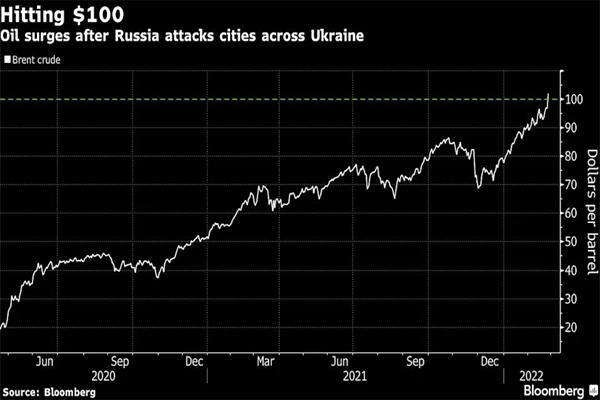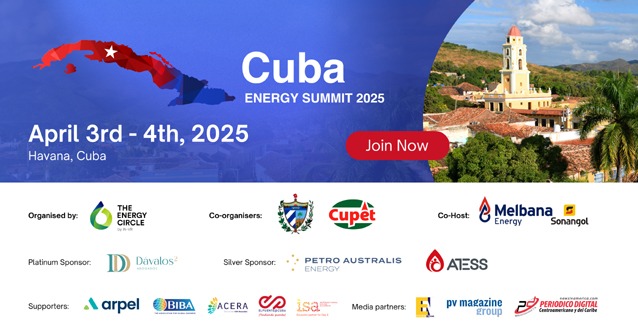- President Putin starts military action that U.S., NATO condemn
- Brent futures rise as much as 9.2%, WTI tops $100 a barrel

Grant Smith, Bloomberg News
LONDON
EnergiesNet.com 02 24 2022
Oil surged above $105 a barrel for the first time since 2014 as Russia attacked sites across Ukraine, triggering fears of a disruption to energy exports at a time of already tight supplies.
Brent jumped more than 9% after President Vladimir Putin ordered Russian troops into Ukraine. Kyiv called it a “full-scale invasion” and announced martial law, while U.S. President Joe Biden said he would impose “severe sanctions” on Moscow.
Natural gas in Europe rose as much as 41%, while metals including gold, aluminum, copper and nickel, and food prices also spiked, piling on inflationary pressures. Russia is a key seller of commodities to global customers, with Europe relying on the nation for about a quarter of its oil and a third of its gas.
The escalation has spooked a market that was already under stress, as oil supplies around the world fail to keep pace with a vigorous recovery in demand as the coronavirus pandemic recedes. The OPEC+ coalition, led by Russia and Saudi Arabia, is struggling to restore production quickly enough, prompting some of the biggest market players to warn of higher prices.
OPEC+ meets on March 2 to decide on output for April. As of Wednesday, delegates from some of the biggest members were saying that triple-digit oil wouldn’t cause them to pump faster. Their current strategy is to add 400,000 barrels a day of crude to the market each month.
It’s possible that OPEC increases production if there’s further escalation, according to Carole Nakhle, founder of consultant Crystol Energy.
“If they think this will threaten the stability of oil markets, I can see them putting more barrels on the market,” she said on a podcast produced by Dubai-based consultant and publisher Gulf Intelligence. It would probably be down to the likes of Saudi Arabia and the United Arab Emirates to boost output because many of the group’s other members would struggle, Nakhle said.
“The oil market will now wait to see how Western nations respond to Russia’s latest actions,” said Warren Patterson, head of commodities strategy at ING Groep NV. “We will likely see even further volatility in the market, as well as the need to price in a larger risk premium.”
The U.S. and Europe will almost certainly respond in the coming hours and days with a far-reaching package of sanctions, Eurasia Group said. Russia’s expulsion from the SWIFT international payment system may even be in play, its analysts said in a note. While Western governments will likely exempt energy transactions from sanctions, the barrage of new restrictions will force many traders to be exceedingly cautious in handling Russian barrels, they said.
U.S. Emergency Reserves
Crude will probably average $110 in the second quarter of the year if the Ukraine conflict escalates, JPMorgan Chase & Co. said this week, before Thursday’s developments. The bank sees prices retreating to average $90 at the end of the year.
The Biden administration is considering tapping its emergency reserves of oil again in coordination with allies to counter the surge in prices, Bloomberg reported on Wednesday. The White House earlier announced sanctions on some Russian banks, sovereign debt and the country’s elites.
Brent for April delivery was at $105.20 a barrel at 10:38 a.m. in London. West Texas Intermediate was at $100. Futures curves are steeply backwardated, a bullish pattern whereby near-term deliveries are more expensive than later ones as physical traders rush to secure supplies.
Inflationary Surge
Crude’s return to triple digits completes a prodigious recovery — barely imaginable a year ago — from the pandemic as the market flips from surplus to scarcity. It reflects a global economy rushing back to normality from Covid-19 and disruptions in the exports of raw materials of all kinds.
“As demand recovers to pre-Covid levels, supply is really having a hard time,” said Giovanni Serio, global head of market analysis at Vitol Group, the world’s biggest independent oil trader.
In addition to oil and gas, Russia is a major producer of aluminum and wheat, which Ukraine also grows. The increase in the price of multiple commodities is contributing to a surge in inflation to the highest level in decades, threatening a cost-of-living crisis for millions and forcing central banks to contemplate a phase of monetary tightening that might choke off the rebound.
“Oil prices continue to surge and are now reaching levels that are uncomfortable for consumers across the world,” Toril Bosoni, head of the International Energy Agency’s markets and industry division, said in a Bloomberg Television interview. “The oil market is incredibly tight.”
While it’s a pressing concern for all consuming nations, the rally has been a particular source of discomfort for Biden, whose attempts to rein in soaring fuel costs ahead of this year’s midterm elections by deploying emergency stockpiles have met with little success.
Biden has pledged to “work like the devil” to get fuel costs under control, stressing the importance of energy security during a recent call with Saudi Arabia’s King Salman.
OPEC+ Pressure
OPEC+ is at the heart of the supply crunch. Besides Riyadh and Abu Dhabi in the Persian Gulf, under-investment and unrest are preventing several members from reviving output following deep cuts during the pandemic. The group delivered only 70% of last month’s scheduled boost, according to the IEA. The Paris-based adviser to rich countries estimates that OPEC+ is now pumping almost 1 million barrels a day of crude less than its target.
The shortfall is creating a further source of anxiety: that global spare capacity to make up for any disruptions — whether in conflict-torn Libya, or from further drone strikes in the UAE and Saudi Arabia — has dwindled to dangerously low levels.
“I’m not necessarily thinking that OPEC is in control of things any more,” said Torbjorn Tornqvist, chief executive officer of commodity-trading house Gunvor Group Ltd. “We’re back in a situation where we’re watching what the spare capacity is going to be.”
Supply constraints go beyond the Organization of Petroleum Exporting Countries and its partners. Investment in new supplies worldwide has contracted as a result of the Covid slump and a diversion of capital away from fossil fuels toward renewable energy. In the U.S., shale explorers have reined in spending on higher output to pay shareholders.
“Under-investment in the oil and gas industry was exacerbated by Covid, but already preceded Covid” in part because of the energy transition, said Vitol’s Serio.
It even extends beyond oil, across the full spectrum of energy derivatives and commodities markets. More raw materials are commanding a higher premium for prompt deliveries than at any point in the past two decades, according to Bloomberg calculations.
“We’re out of everything — I don’t care if it’s oil, gas, coal, copper, aluminum, you name it, we’re out of it,” Jeff Currie, head of commodities research at Goldman Sachs Group Inc., said in a recent Bloomberg TV interview. “I’ve been doing this 30 years and I’ve never seen markets like this.”
This creates a profound dilemma for Western powers. Imposing a financial cost on Russia for its actions in Ukraine, for example by putting sanctions on oil and gas exports, could cause just as much pain for their own economies.
bloomberg.com 02 24 2022












